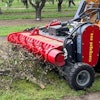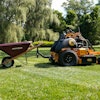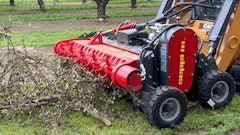
Grapples can help tackle tough jobs with greater ease and efficiency. These attachments go well beyond basic hauling and digging, offering unique solutions for challenging applications that would be tricky with just a bucket. Let’s dive into three interesting ways to put your grapple to work.
1. Clear and sort heavy debris on jobsites or properties
One of the most useful ways to use a grapple is for heavy-duty cleanup on construction sites, large properties or anywhere dense debris piles up. Buckets or root grapples are perfect for picking up rocks, logs, scrap or bulky branches that would otherwise need to be managed by hand or multiple trips with a standard bucket.
What makes a grapple stand out is its ability to grip uneven loads securely, allowing you to clear large piles of debris in fewer trips and with more control. Grapples from top-tier manufacturers can even allow you to lift more—and therefore do more. These grapples are designed to be both lightweight and strong, reserving more of the carrier’s rated lifting capacity for materials handling. This innovative design allows operators to transport a full load—even with uneven debris—without sacrificing stability.
2. Prep sites by digging up stumps and concrete slabs
When it comes to prepping a site for landscaping or construction, stump removal can be one of the toughest jobs—and that’s where a stump bucket grapple shines. Designed with a narrow bucket and serrated edges, the stump bucket grapple digs into the ground, securely grips stumps, roots and rocks and rips them out with impressive breakout force. The benefits don’t stop at stump removal. Thanks to its unique design, a stump bucket grapple can also get under concrete slabs, making it easier to break them up and remove heavy debris. This versatility is essential for demolition-type applications, where you often need to manage multiple materials at once. By streamlining the process of clearing out stumps and concrete, you can prep a plot of land faster and more effectively without needing multiple attachments or a separate machine for each task.
Additionally, some manufacturers are applying a similar concept to more traditional root grapples. Rather than tines with a consistent depth from the front to the back of the attachment, some root grapples feature deeper tines for better digging in the first six inches of the attachment, then taper off slightly to allow for a better breakout force. With this design, operators are able to get under roots or even concrete slabs and then use the power and weight of the carrier to pry up even the most difficult debris.
3. Handle odd-shaped or oversized materials with ease
When you’re handling awkwardly shaped or oversized loads, like long logs, big rocks or piles of branches, grapples provide a secure, steady grip, which is something buckets alone can’t match.
The hydraulically operated portion of the grapple can adjust to odd shapes and prevent materials from slipping during transport. For instance, a rake grapple combines the wide-open design of a rake with the added benefit of a clamping top, so you can haul branches, logs or heavy brush across properties without a trail of debris falling off. With utility and bucket grapples, which are versatile enough to manage everything from landscape waste to loose rocks, operators can easily secure their load tightly, making it easier to transport and load items without having to stop and clean up.
Grapples equipped with features like hydraulic cylinder protection and full nylon hose sleeves also add a layer of durability, ensuring that your equipment stays operational longer and minimizes downtime on the job. These enhancements not only extend the life of your grapple but also ensure safer operation, so you can focus on the task at hand.
Get the right grapple for the job
When it comes to putting a grapple to work in unique applications, selecting the right type of grapple for your specific needs is essential. Each grapple type offers different strengths, so choosing the right one can make all the difference in productivity and efficiency. If you’re not sure which grapple best matches your equipment and application, work closely with your attachment manufacturer or dealer. They can help you find the right fit for your machine’s specifications, from hydraulic needs to lifting capacity, so you get a tool that’s up for the challenge.
With the right grapple on your compact equipment, tough jobs become easier, downtime gets reduced, and the workday becomes that much smoother.



















